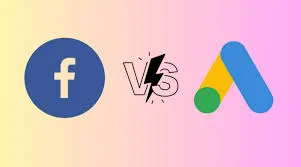Product Reviews
Facebook Ads vs Google Ads: Finding the Right Fit for Your Brand

In the vast expanse of digital advertising, the dynamic duo of Facebook Ads and Google Ads emerges as the linchpin for brand success. Navigating the nuanced realms of social engagement and search intent, businesses strive to discern the optimal platform. Join us on a journey through this comprehensive guide, where we unravel the intricacies of Facebook Ads vs Google Ads, empowering you to make informed choices that resonate with your brand’s unique identity. Let’s delve into the world of online marketing, exploring the strengths and subtleties of each platform to help you discover the perfect fit for your brand in the ever-evolving landscape of digital promotion.
Understanding Facebook Ads
Facebook Ads provides a versatile platform for businesses to create targeted campaigns. Leveraging the vast user base of over 2.8 billion monthly active users, businesses can reach specific demographics based on age, location, interests, and more.
- Ad Formats
- Image Ads: Single-image ads are a simple yet effective way to showcase your product or service. With a compelling image and concise copy, businesses can quickly capture the audience’s attention.
- Video Ads: Video content has become increasingly popular on social media. Facebook’s video ads enable brands to tell a story, demonstrate products, or engage audiences with dynamic visuals.
- Carousel Ads: These allow businesses to display multiple images or videos within a single ad, encouraging users to swipe through and explore various aspects of the brand.
- Slideshow Ads: Combining images, text, and sound, slideshow ads are a cost-effective alternative to video ads, offering an engaging visual experience.
- Targeting Options
- Demographic Targeting: Facebook’s in-depth demographic targeting lets you define your audience based on factors like age, gender, education, and relationship status.
- Interest-Based Targeting: Reach users based on their interests, hobbies, and activities, ensuring your ads are seen by those likely to engage with your content.
- Behavioral Targeting: Target users based on their online behavior, including purchase history, device usage, and more.
- Custom Audiences: Import your customer data to target existing customers or create lookalike audiences to reach users with similar characteristics.
- Ad Placement
- Facebook Feeds: Ads appear directly in users’ News Feeds, blending seamlessly with organic content.
- Instagram Feeds and Stories: Extend your reach by placing ads on Instagram, which is part of the Facebook family.
- Audience Network: Display ads on third-party websites and apps, increasing visibility across the internet.
- Messenger: Engage users through ads in the Messenger app, promoting direct interaction.
Unpacking Google Ads
Google Ads, previously known as Google AdWords, is a robust advertising platform that leverages the power of the world’s most popular search engine. With billions of searches conducted daily, businesses can capitalize on Google Ads to appear at the top of search results and across various Google partner websites.
- Ad Formats
- Search Ads: Text-based ads that appear above or below organic search results, ensuring high visibility when users are actively searching for related products or services.
- Display Ads: Visual ads, including images and banners, are displayed on websites within the Google Display Network. These ads can be targeted based on demographics, interests, and website placements.
- Video Ads: Capitalize on the popularity of YouTube by running video ads that play before or during videos. Video ads are an excellent way to convey complex messages or showcase product demonstrations.
- Shopping Ads: Ideal for e-commerce businesses, shopping ads showcase products directly within the search results, complete with images, prices, and product details.
- Keyword Targeting
- Keywords: Select relevant keywords for your business to trigger your ads when users search for those terms. Google Ads operates on a pay-per-click (PPC) model, meaning you only pay when users click on your ad.
- Match Types: Choose from broad match, phrase match, exact match, or broad match modifier to refine your keyword targeting strategy.
- Negative Keywords: Exclude specific keywords to ensure your ads don’t appear for irrelevant searches, saving budget and improving targeting precision.
- Ad Placement
- Search Network: Display ads on Google’s search engine results pages (SERPs) when users search for relevant keywords.
- Display Network: Extend your reach across a vast network of websites, reaching users as they browse content related to your products or services.
- YouTube: Run video ads on YouTube to engage users watching content related to your industry.
- Google Maps: Promote your business through location-based ads when users search for products or services in your vicinity.
Choosing the Right Platform for Your Brand
- Consider Your Goals
- Brand Awareness: If your primary goal is to build brand awareness and engage a broad audience, Facebook Ads may be the ideal choice, thanks to its diverse ad formats and extensive targeting options.
- Lead Generation and Sales: Google Ads, with its intent-driven approach, is well-suited for businesses aiming to capture leads or drive direct sales. Utilize search ads to reach users actively seeking your products or services.
- Understand Your Audience
- Social Engagement: If your target audience is highly active on social media and values visual content, Facebook Ads can help create a strong brand presence.
- Search Intent: For businesses targeting users actively searching for specific products or services, Google Ads ensures your ads appear when potential customers are in the decision-making phase.
- Budget and Cost Considerations
- Facebook Ads: Offers flexibility with budgeting and bidding options, making it suitable for businesses with varying budget sizes.
- Google Ads: Operates on a competitive bidding model, where the cost per click (CPC) can vary based on keyword competitiveness. Plan your budget accordingly to ensure optimal performance.
Conclusion
In the dynamic world of online advertising, a strategic combination of Facebook Ads and Google Ads can yield remarkable results for your brand. Understanding the strengths and nuances of each platform is key to maximizing your marketing efforts. Whether you’re aiming to boost brand awareness, drive sales, or generate leads, the right blend of Facebook Ads and Google Ads can propel your brand to new heights in the digital landscape. Evaluate your goals, know your audience, and craft compelling campaigns tailored to each platform for a well-rounded and effective online advertising strategy.
